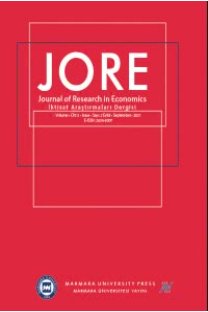TÜRKİYE İÇİN EKONOMETRİ VE MAKİNE ÖĞRENMESİ YOLUYLA İŞSİZLİKTEN İSTİHDAMA GEÇİŞ OLASILIKLARININ TAHMİNİ: KARŞILAŞTIRMALI BİR ÇALIŞMA
PREDICTION OF TRANSITION PROBABILITIES FROM UNEMPLOYMENT TO EMPLOYMENT FOR TURKEY VIA MACHINE LEARNING AND ECONOMETRICS: A COMPARATIVE STUDY
In this study, it is mainly aimed to predict transition probabilities of individuals who are previouslyunemployed and get employment or stay unemployed. In order to do that, Household Labor ForceSurveys conducted in Turkey are merged and matched from 2004 to 2016. Information aboutindividuals only consists of individual characteristics and qualifications since there should not be anyinformative clue about the present situation. To predict those probabilities, logistic regression analysisas econometric approach, a shallow neural network and machine learning classification algorithms arerun in order to compare them. The results indicate that classification in machine learning is slightlybetter than logistic regression and shallow neural network. While XGBoost classifier and RandomForest get 67% accuracy, logistic regression can predict only 63% of an individual’s transition andshallow neural network forecasts 51%.
Keywords:
Employment, Transition Probability Machine Learning, Classification,
___
- Acemoglu, D. (2002). Technical change, inequality, and the labor market. Journal of economic literature, 40(1):7 72.
- Acemoglu, D. and Shimer, R. (1999). Holdups and efficiency with search frictions. International Economic Review, 40(4):827–849.
- Ashenfelter, O., Harmon, C. and Oosterbeek, H. (1999). A review of estimates of the schooling/earnings relationship, with tests for publication bias. Labour economics, 6(4):453–470.
- Becker, G. (1964). Human capital: a theoretical and empirical analysis, with special reference to education. National bureau of economic research publications: General series. National Bureau of Economic Research; distributed by Columbia University Press.
- Blundell, R., Dearden, L., Meghir, C. and Sianesi, B. (1999). Human capital investment: the returns from education and training to the individual, the firm and the economy. Fiscal studies, 20(1):1–23.
- Bougheas, S. and Georgellis, Y. (2004). Early career mobility and earnings profiles of german apprentices: Theory and empirical evidence. Labour, 18(2):233–263.
- Breiman, L. and Spector, P. (1992). Submodel selection and evaluation in regression. The x-random case. International statistical review/revue internationale de Statistique, 291–319.
- Chollet, F. et al. (2015). Keras. https://keras.io.
- Cingano, F. (2003). Returns to specific skills in industrial districts. Labour Economics, 10(2):149–164.
- Dearden, L. (1998). Ability, families, education and earnings in Britain. Technical report, IFS Working Papers.
- Donaldson, D. and Eaton, B. C. (1976). Firm-specific human capital: a shared investment or optimal entrapment? Canadian Journal of Economics, 462–472.
- Greene, W. H. (2003). Econometric analysis. Pearson Education, India.
- Higashi, Y. (2002). Firm specific human capital and unemployment in a growing economy. Japan and the world economy, 14(1):35–44.
- İlkkaracan, İ. (2012). Why so few women in the labor market in turkey? ˙ Feminist Economics, 18(1):1–37.
- James, G., Witten, D., Hastie, T. and Tibshirani, R. (2013). An introduction to statistical learning, 112. Springer.
- Krueger, A. and Ashenfelter, O. (1992). Estimates of the economic return to schooling from a new sample of twins. Technical report, National Bureau of Economic Research.
- Mincer, J. (1974). Schooling, experience, and earnings. Human Behavior & Social Institutions, 2.
- Mincer, J. and Ofek, H. (1982). Interrupted work careers: Depreciation and restoration of human capital. Journal of Human Resources, 3–24.
- Parsons, D. O. (1972). Specific human capital: An application to quit rates and layoff rates. Journal of political economy, 80(6):1120–1143.
- Pedregosa, F., Varoquaux, G., Gramfort, A., Michel, V., Thirion, B., Grisel, O., Blondel, M., Prettenhofer, P., Weiss, R., Dubourg, V., Vanderplas, J., Passos, A.,
- Cournapeau, D., Brucher, M., Perrot, M. and Duchesnay, E. (2011). Scikit-learn: Machine learning in Python. Journal of Machine Learning Research, 12:2825–2830.
- Psacharopoulos, G. (1994). Returns to investment in education: A global update. World Development, 22(9):1325–1343.
- Rousseeuw, P. J. and Bassett Jr, G. W. (1990). The remedian: A robust averaging method for large data sets. Journal of the American Statistical Association, 85(409):97–104. Tansel, A. and Tasci, H. M. (2004). Determinants of unemployment duration for men and women in Turkey, IZA Discussion Paper no. 1258.
- Tasci, H. M. and Ozdemir, A. R. (2006). Trends in long-term unemployment and determinants of incidence of long-term unemployment in Turkey, Journal of Economic and Social Research, 7(2): 1-33.
- Tasci, H. M. and Tansel, A. (2005). Unemployment and transitions in the turkish labor market: evidence from individual level data, IZA Discussion Paper no. 1663.
- Tunali, İ. and Ercan, H. (2003). Background study on labour market and employment in Turkey. European Training Foundation, Torino (June 2003). Wasmer, E. (2006). General versus specific skills in labor markets with search frictions and firing costs. American Economic Review, 96(3):811–831.
- ISSN: 2636-8307
- Başlangıç: 2016
- Yayıncı: Marmara Üniversitesi
Sayıdaki Diğer Makaleler
BANKACILIK SEKTÖRÜNDE SORUNLU KREDİ OLUŞUMUNUN TESPİTİNE BİLİMSEL YAKLAŞIM
Mustafa CERAN, Serpil ERGÜN BÜLBÜL
TÜRKİYE ORTA GELİR TUZAĞINDA MI YOKSA SÜREKLİ DÜŞÜK BÜYÜMENİN KISKACINDA MI?
Fatma DOĞRUEL, A. Suut DOĞRUEL
SİGARAYI BIRAKMA VE OBEZİTE ARASINDAKİ İLİŞKİ: TÜRKİYE ÖRNEĞİ
